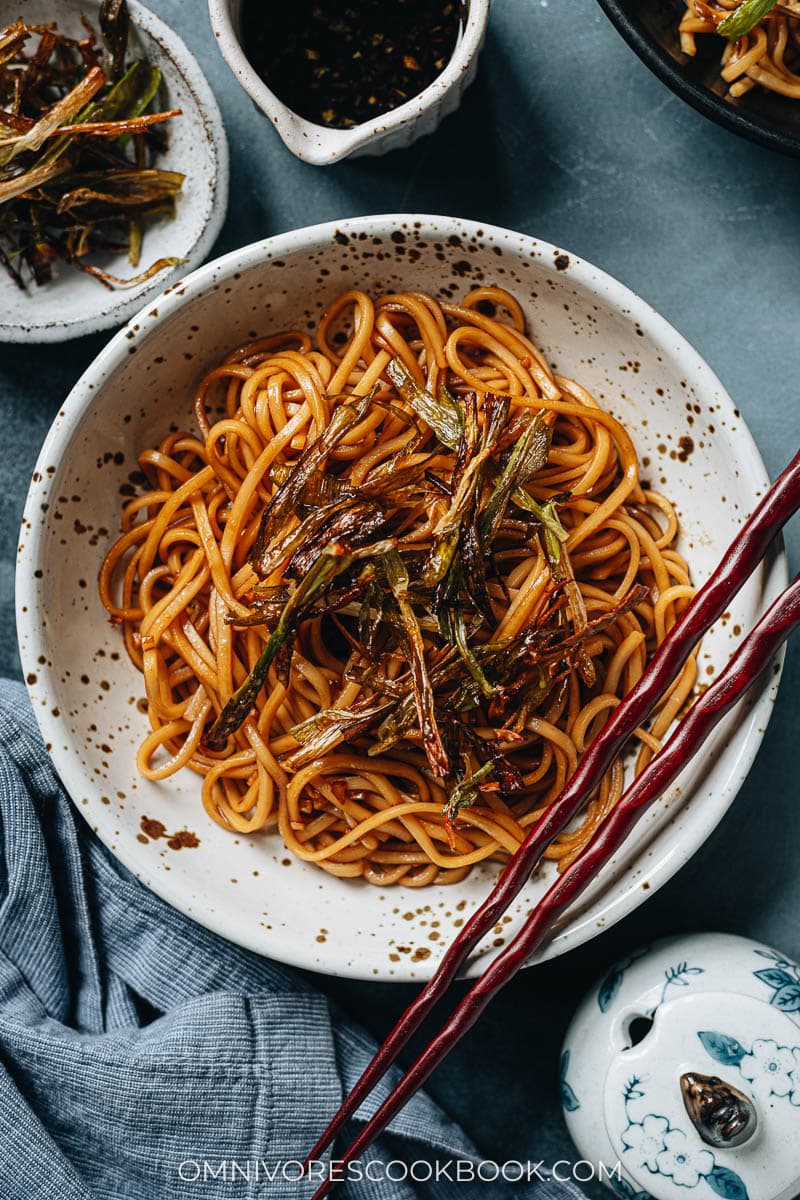
In China, noodle dishes come in all kinds of forms and flavors depending on the region. In Beijing, I grew up eating Fried Sauce Noodles (Zha Jiang Mian) and Pork Gravy Noodles (Da Lu Mian). In Southern China, fried noodles such as Chow Mein, Lo Mein, and Mei Fen are everyday staples. If you like spicy food, try spicy cold Dan Dan Noodle from Sichuan and mung bean noodles in hot and sour soup (Suan La Fen) from Chongqing. You can find fat noodles with chili oil (Biang Biang Mian), hearty beef noodle soup (Lan Zhou La Mian) and spicy tingling Cumin Lamb Noodles in central China.
Today, I want to share one of my favorite noodle dishes from Shanghai cuisine – scallion oil noodles.
What is scallion oil noodles
Scallion oil noodle, or 葱油拌面 (cong you ban mian), is a famous Shanghai dish. It is a super simple and flavorful dish you can get from street vendors or hole-in-the-wall restaurants. To make the sauce, you use a bunch of green onions to make a fragrant scallion oil while producing crispy caramelized scallions that are mildly sweet. The oil is then quickly cooked with soy sauce and a touch of sugar, to create a savory noodle sauce that is simple yet big in flavor. Just mix the sauce and crispy scallions with thin wheat noodles, and you will get a rich and fragrant noodle dish that is so satisfying to eat.
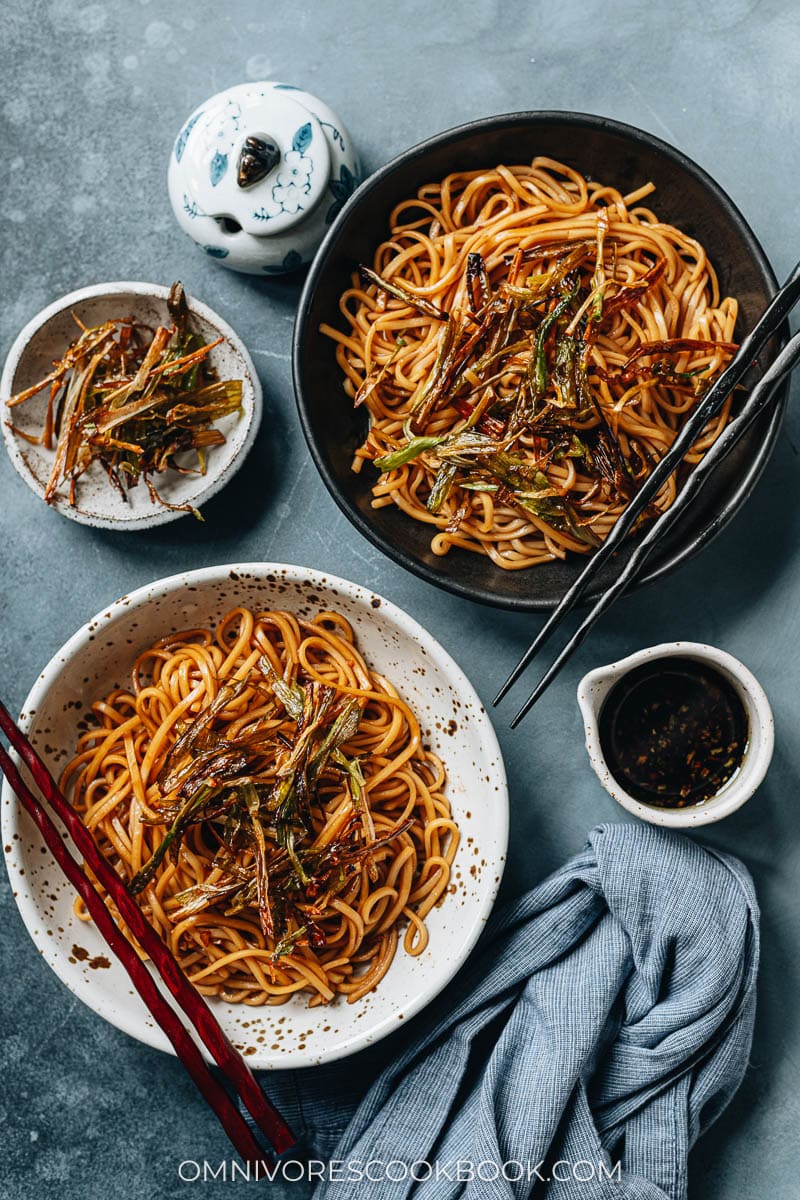
A slightly improved recipe
The key to making great scallion oil noodles is to nail the scallion oil, and to use a good sauce-to-noodle ratio. I shared this recipe a while ago using the traditional approach, but I updated it slightly for an even better result based on my experience over the years.
- Use less oil
Traditional scallion oil noodles use quite a bit of oil. You will need to slow cook the scallion for a long time to infuse the oil. In this recipe, I reduced the amount of oil so it’s just enough to make a batch of the sauce. By reducing the oil, the scallions will char quickly so you can reduce the cooking time. You will also get a very fragrant sauce since the scallion-to-oil ratio will have increased.
- Use some garlic to add even more flavor
Most of the traditional scallion oil noodles recipes do not contain garlic, but I found that a small amount goes a long way. It makes this simple sauce even richer with a very complex and balanced flavor.
Scallion oil noodle ingredients
What type of noodle to use
Thin wheat noodles work best for scallion oil noodles. I used Wife’s Noodles from Havista. It is a type of semi-fresh noodles that have a really good texture and taste very similar to fresh noodles. If you don’t have access to them, dried thin wheat noodles such as udon noodles will work great. The main ingredients should be wheat and water.
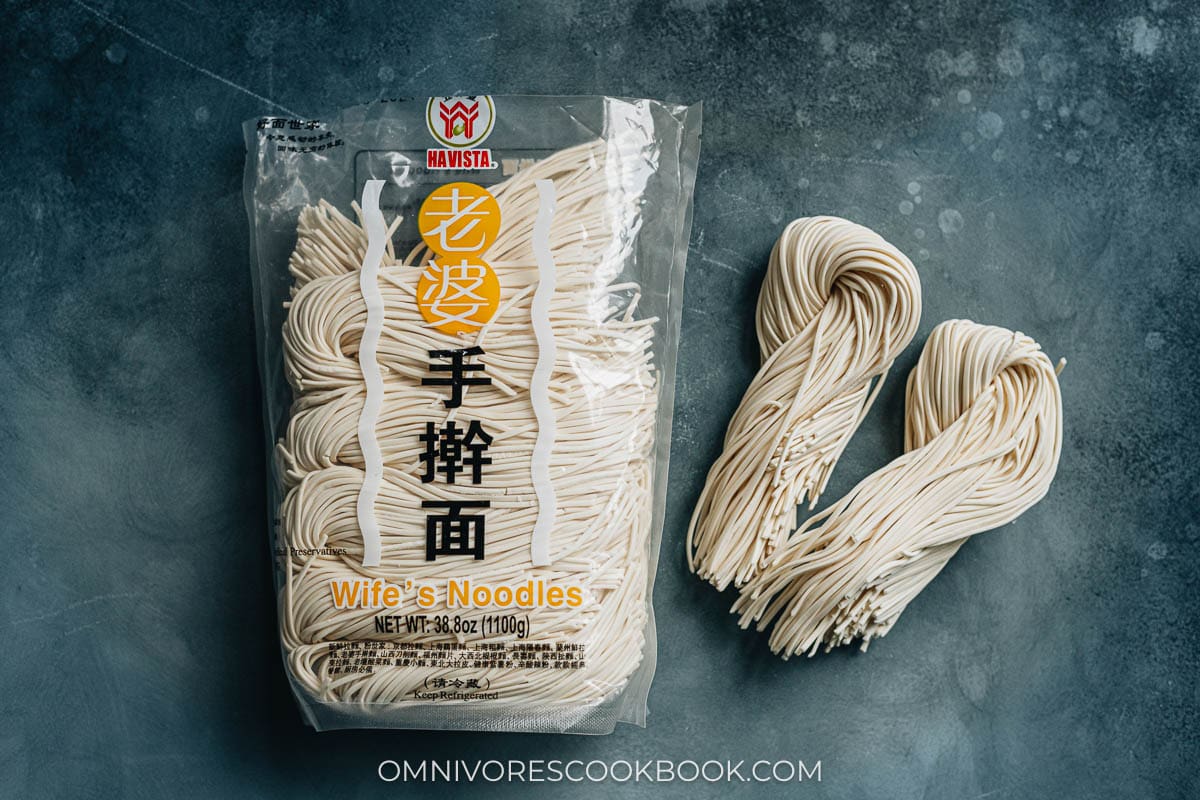
How to cut the scallion
- Cut the scallions to 2” (5 cm) long slices.
- Thinly slice the scallions. Depending on the size of the scallions you use, you can either quarter them lengthwise, or julienne them.
It’s important to thinly slice the scallions into even pieces so they will crisp up nicely.
Mise en place
The ingredients you need for scallion oil noodles are super simple.
- Light soy sauce
- Dark soy sauce
- Sugar
- Oil (any neutral oil would work)
- Minced garlic
- Julienned scallions
- Noodles
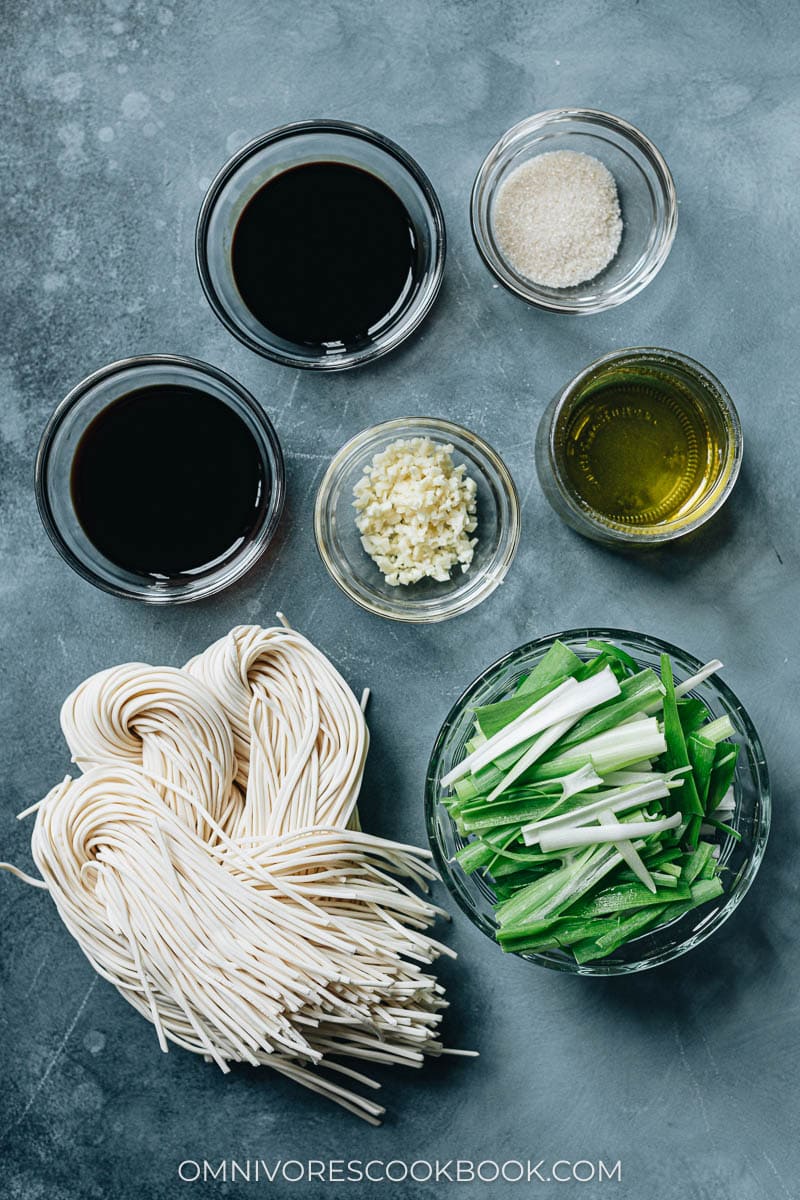
How to make scallion oil noodle
- Cook the scallions in the oil until crispy, then remove the fried scallion
- Briefly cook the minced garlic until lightly golden
- Add the soy sauce and sugar
- Simmer the sauce briefly

Once you’ve made the sauce, simply mix the sauce with cooked noodles and garnish by sprinkling the crispy scallions on top.
The sauce might not look like a lot, but it is very rich and flavorful so a small amount goes a long way. Infused with the aroma of the scallion and garlic, the noodles are quite bold in taste. The crispy scallion is mild and slightly sweet, adding a nice texture to the mix.
How to serve scallion oil noodles
Scallion oil noodle is originally a street food and is usually served as a snack or as breakfast. When making the dish at home, I enjoy serving it as a side dish along with other veggies and protein dishes. In the warmer months, I also like to serve it as a light meal for lunch. To make it a more significant meal, top the noodles with some sliced cucumber and tomato, plus some shredded leftover chicken or beef. You can also brown some ground meat (chicken, pork and beef all work well) and add it to the noodle sauce, to use as a topping.
Scallion noodle sauce can be made ahead and saved for later. You should store the fried scallions separately so they remain somewhat crispy.
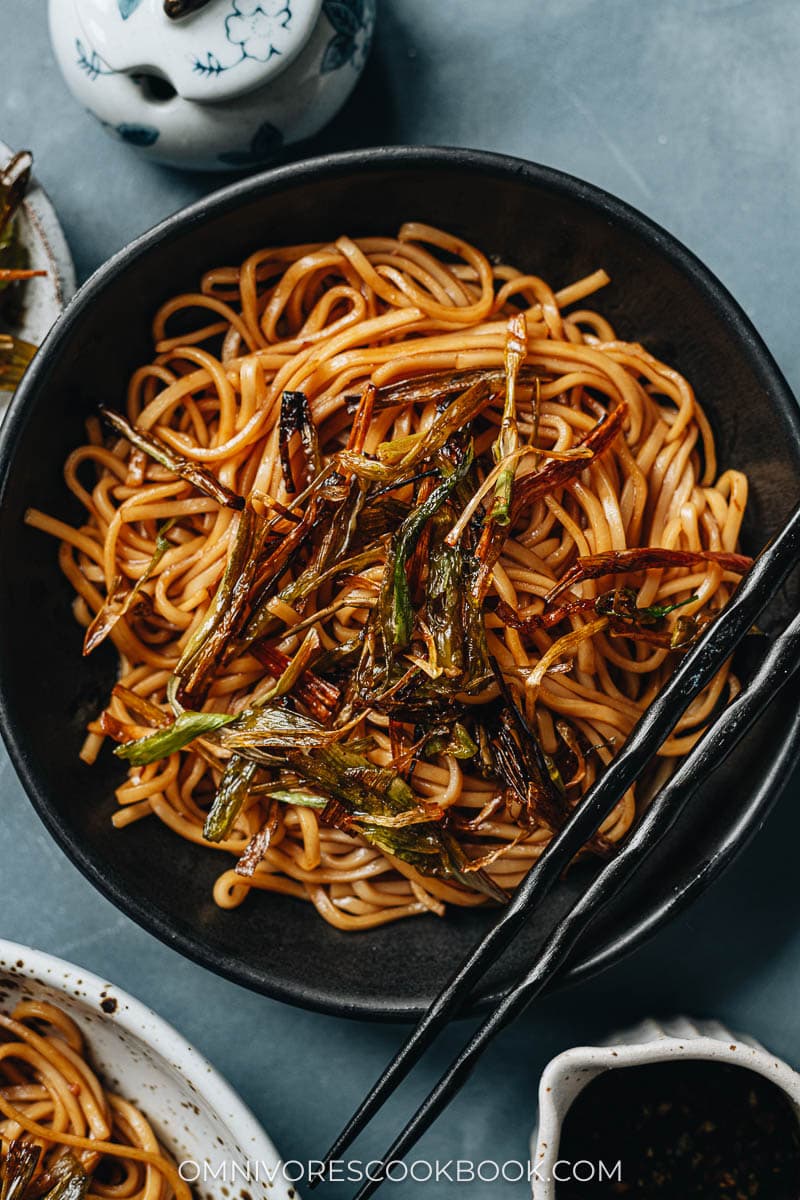
Other delicious noodle recipes
- Easy Soy Sauce Noodles (阳春面)
- Chongqing Noodles (重庆小面)
- Green Bean Noodles (豆角焖面)
- Chinese Chicken Noodle Salad (鸡丝凉面)
- Da La Pi (大拉皮, Northern Chinese Potato Noodles in Sesame Sauce)
Chinese Cooking Made Easy
Are you new to this website? This free email series is a great place to start. I’ll walk you through a few of my most popular recipes and show you how and why they work. You’ll quickly start to cook better Chinese food in your own kitchen.
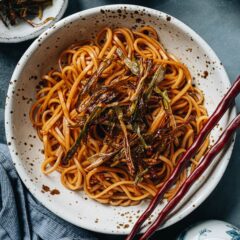
Shanghai Scallion Oil Noodle (葱油拌面)
Ingredients
- 6 to 8 scallions (*Footnote 1)
- 1/4 cup vegetable oil (or any neutral oil)
- 3 tablespoons light soy sauce
- 2 cloves garlic , coarsely chopped
- 2 1/2 tablespoons dark soy sauce
- 2 teaspoons sugar
- 1 lb (450 g) fresh thin wheat noodles , or 12 oz (340 g) dried thin wheat noodles (*footnote 2)
Instructions
- Cut the scallions into 2” (5 cm) long pieces, then julienne into thin strips. If using very thin scallions, you can also quarter them lengthwise if it’s easier. Dry the green onions thoroughly before cooking to prevent oil splatter.
- Add oil to a frying pan and heat over medium heat until hot, but not smoking. Add the scallions and spread them out as much as you can. Cook over medium heat, stirring constantly until the green onions turn golden brown. Turn to medium-low heat if the scallions brown too quickly and start to burn. Some scallion pieces might brown faster than others. Transfer the browned green onions with a pair of tongs or chopsticks and place in a bowl, until all the scallion pieces are cooked. Save the cooked scallions for later.
- Add the minced garlic to the oil. Cook and stir until turning lightly golden.
- Pour in the light soy sauce, dark soy sauce and sugar. Simmer and stir for 1 minute or so. Turn off the heat and set the sauce aside.
- Bring a large pot of water to a boil. Cook noodles according to instructions. Once cooked, drain noodles and transfer to serving plates.
- Portion the noodles into serving bowls, add a few spoonfuls of the noodle sauce into each bowl and garnish with fried green onions. Serve the noodle with the rest of the sauce on the side. Mix the noodles with sauce before eating. Add more sauce if needed.
Video
Notes
- Depending on the size of the scallions, you might need more or less. If your scallions are super thin, use 8. For bigger scallions with thicker stems, use 6.
- Any type of thin wheat noodles work in this recipe, such as Chinese wheat noodles (挂面, Gua Mian), dried Udon noodles, spaghetti, and fresh noodles.
Nutrition
Have a question or feedback? Add a Comment
Did you make this? I want to see! Tag @OmnivoresCookbook on Instagram, and rate the recipe below.

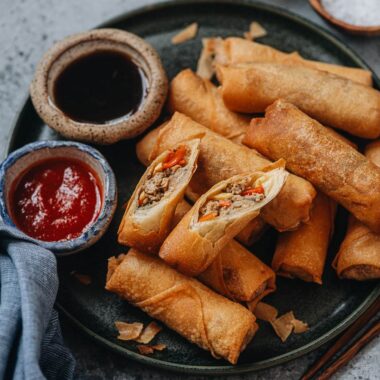
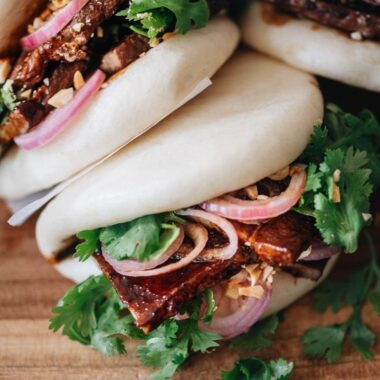
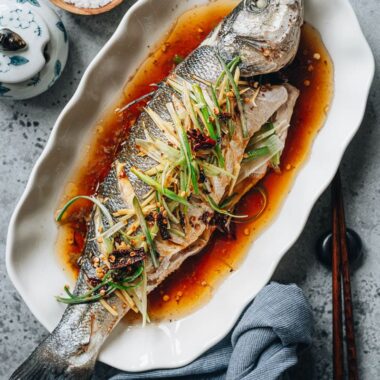
Bill Zigrang
Maggie,
I note that the new version of your recipe omits oyster sauce. ?Omission? ?revision? Please comment.
P.S. I still don’t like the lack of editing capability in your new recipe format, but, “Oh, well”.
P.P.S. Congrats on the ATK gig.
Bill Zigrang
OOPS! I see that the oyster sauce wes for the additional optional topping.
BZ
Maggie Zhu
The recipe was updated once in the past. My original recipe had an optional topping (it’s a basic stir fry with protein of your choice and vegetable). But since authentic scallion oil noodles usually served plain like this and do not have a topping, I ended up omitting the topping in my recipe revision.
PS. I actually have no idea that you can edit the recipes in the old format. I guess I don’t use my website that way so I didn’t even know the feature exist.
Do you edit the recipe when you choose to print it? Or are you talk about scaling the recipe? I can ask my web designer about this feature if you can describe how it used to work.
JSkellz
Great recipe, thank you! I just wanted to know…
1. Is there a sign that the sauce has cooked in the pan long enough? E.g. Am I waiting for it to become sticky or something?
2. Once the sauce is made, how best to store it and roughly how long will it keep for?
Thank you!
Maggie Zhu
The sauce cooks very fast, and it won’t become sticky. You only need 1 minute or so to cook off the raw taste of the soy sauce.
Once you made the sauce, you can keep it in an airtight container in the fridge for quite a long time. The salt preserves it and it should stay good for at least a week, if not longer. But I wouldn’t store it for too long because I think the fragrance from the scallion oil and garlic will gradually decrease.
Laurel
I just received my copy of your “Chinese Homestyle” cookbook. I immediately went to the noodle section and got pulled in to the scallion oil noodle recipe. Only problem was that nowhere does it say how much or what type of oil to use. So I came here to see if I could find it. Just a head’s up as a correction for your next edition.
Rose
This looks so good! I’m definitely going to try making it this week. One question though, when does the oyster sauce get added? I don’t see it in the recipe instructions.
Maggie Zhu
Sorry about this! You should add it during step 1 while mixing the sauce. Just updated the recipe to reflect this.
Sabrina
The scallion oil and stir fry are excellent – I’ll make them again. However, I used fresh wheat noodles (called Da Xi Bei Gungun Noodles), followed cooking directions, and they turned out ‘gummy’. Is that typical for wheat noodles? What is your favorite noodle for this recipe?
Maggie
Hi Sabrina, I’m glad to hear you like my recipe!
Re noodles – it’s strange that these noodles didn’t turn out well. I just googled and it looks like a good one.
I always prefer to use fresh noodles if I can find them. One of the semi-fresh types I like is called Shanxi Planed noodles (you can find the picture of the noodles in this post: https://omnivorescookbook.com/chinese-gravy-noodles). It’s packaged and stored in the refrigirated area. The noodles are lightly dried, so you can store it for a longer time. I really like the texture of these noodles and they work well with noodle sauce.
Sabrina
Hmmm – I’ve been thinking about the Da Xi Bei Gungun noodles and I’m pretty sure I’ve used them before and they turned out fine. I did a little research and I think my problem was I was cooking a bigger batch than normal and my pot was too small. I’ll try again. Anyway, thank you for your recipes and your comments!
J-Mom
This is sooo good! It’s surprising how such few simple ingredients can make a great sauce. Thank you for the recipe.
Jean Rabefaniraka
Salut Maggie !
Vos recettes sont aussi délicieuses qu’authentiques..et vous êtes devenue ma principale source d’inspiration quand je veux épater mes amis ou ma famille. Merci pour votre partage et continuez à côtoyer l’excellence ! ??
Maggie
Thanks so much for your kind words Jean! I’m glad to hear you like my website 🙂 Happy cooking and hope you and your family have a delicious week ahead!
Christine | Vermilion Roots
I must make this soon! It’s easy enough to whip together quickly. It’s great learning about all the different Chinese noodle dishes. Cant wait to explore more!
Soe
Haha omg I laughed so hard when you said a Shanghai person will beat you with a wok when he/she sees this. I want to try making all your noodle dish 😀
Jess Wright @ The Cookbook Obsession
I love everything about this! I am kind of noodle obsessed, I’ve never had much luck with rice noodles, though. They always clump together and don’t hold the sauce. I think I will try this recipe and see if my results are more successful 🙂